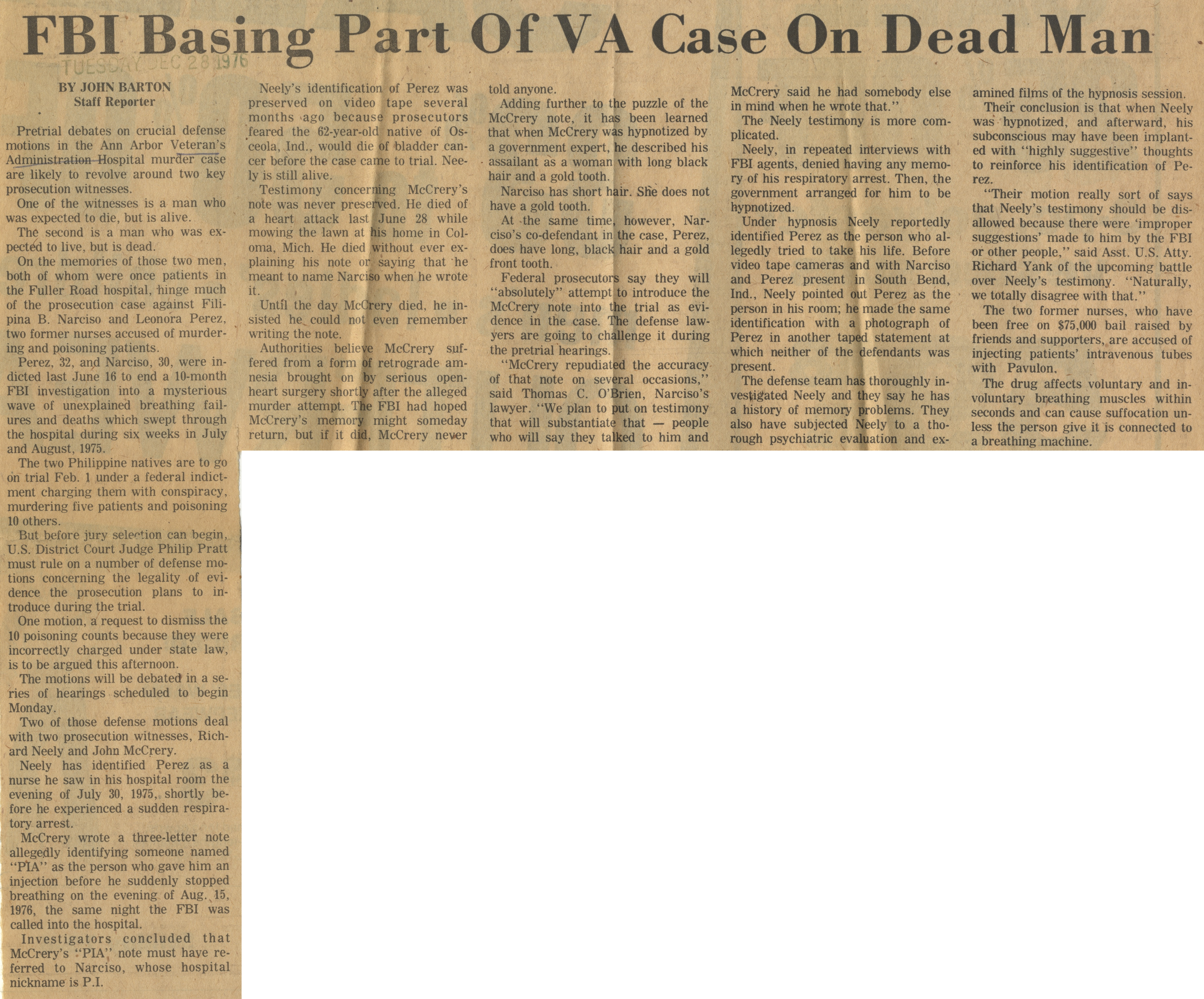FBI Basing Part Of VA Case On Dead Man

FBI Basing: Part Of VA Case On Dead Man
BY JOHN BARTON Staff Reporter
Pretrial debates on crucial defense motions in the Ann Arbor Veteran’s Administration-Hospital murder case are likely to revolve around two key prosecution witnesses.
One of the witnesses is a man who was expected to die, but is alive.
The second is a man who was expected to live, but is dead.
On the memories of those two men, both of whom were once patients in the Fuller Road hospital, hinge much of the prosecution case against Filipina B. Narciso and Leonora Perez, two former nurses accused of murdering and poisoning patients.
Perez, 32, and Narciso, 30, were indicted last June 16 to end a 10-month FBI investigation into a mysterious wave of unexplained breathing failures and deaths which swept through the hospital during six weeks in July and August, 1975.
The two Philippine natives are to go on trial Feb. 1 under a federal indictment charging them with conspiracy, murdering five patients and poisoning 10 others.
But before jury selection can begin, U.S. District Court Judge Philip Pratt must rule on a number of defense motions concerning the legality of evidence the prosecution plans to introduce during the trial.
One motion, a request to dismiss the 10 poisoning counts because they were incorrectly charged under state law, is to be argued this afternoon.
The motions will be debated in a series of hearings scheduled to begin Monday.
Two of those defense motions deal with two prosecution witnesses, Richard Neely and John McCrery.
Neely has identified Perez as a nurse he saw in his hospital room the evening of July 30, 1975, shortly before he experienced a sudden respiratory arrest.
McCrery wrote a three-letter note allegedly identifying someone named “PlA” as the person who gave him an injection before he suddenly stopped breathing on the evening of Aug. 15, 1976, the same night the FBI was called into the hospital.
Investigators concluded that McCrery’s ‘‘PIA’’ note must have referred to Narciso, whose hospital nickname is P.I.
Neely’s identification of Perez was preserved on video tape several months ago because prosecutors feared the 62-year-old native of Osceola, Ind., would die of bladder cancer before the case came to trial. Neely is still alive.
Testimony concerning McCrery’s note was never preserved. He died of a heart attack last June 28 while mowing the lawn at his home in Coloma, Mich. He died without ever explaining his note or saying that he meant to name Narciso when he wrote it.
Until the day McCrery died, he insisted he could not even remember writing the note.
Authorities believe McCrery suffered from a form of retrograde amnesia brought on by serious open-heart surgery shortly after the alleged murder attempt. The FBI had hoped McCrery’s memory, might someday return, but if it did, McCrery never told anyone.
Adding further to the puzzle of the McCrery note, it has been learned that when McCrery was hypnotized by a government expert, he described his assailant as a woman with long black hair and a gold tooth.
Narciso has short hair. She does not have a gold tooth.
At the same time however, Narciso’s co-defendant in the case, Perez, does have long, black hair and a gold front tooth.
Federal prosecutors say they will "absolutely” attempt to introduce the McCrery note into the trial as evidence in the case. The defense lawyers are going to challenge it during the pretrial hearings.
“McCrery repudiated the accuracy of that note on several occasions,” said Thomas C. O'Brien, Narciso’s lawyer. “We plan to put on testimony that will substantiate that — people who will say they talked to him and McCrery said he had somebody else in mind when he wrote that.”
The Neely testimony is more complicated.
Neely, in repeated interviews with FBI agents, denied having any memory of his respiratory arrest. Then, the government arranged for him to be hypnotized.
Under hypnosis Neely reportedly identified Perez as the person who allegedly tried to take his life. Before video tape cameras and with Narciso Perez present in South Bend Ind., Neely pointed out Perez as the person in his room; he made the same identification with Perez in another taped statement at which neither of the defendants was present.
The defense team had thoroughly investigated Neely and they say he has a history of memory problems. They also have subjected Neely to a thorough psychiatric evaluation and examined films of the hypnosis session.
Their conclusion is that when Neely was hypnotized, and afterward, his subconscious may have been implanted with “highly suggestive” thoughts to reinforce his identification of Perez.
“Their motion really sort of says that Neely’s testimony should be disallowed because there were ‘improper suggestions’ made to him by the FBI or other people,” said Asst. U.S. Atty. Richard Yank of the upcoming battle over Neely’s testimony. “Naturally, we totally disagree with that.”
The two former nurses, who have been free on $75,000 bail raised by friends and supporters, are accused of injecting patients’ intravenous tubes with Pavulon.
The drug affects voluntary and involuntary breathing muscles within seconds and can cause suffocation unless the person give it is connection to a breathing machine.
Article
Subjects
John Barton
Assimilative Crimes Act
Crime & Criminals
Criminal Investigations
Federal Bureau of Investigation (FBI)
Murder Investigations
Pavulon Muscle Relaxant
Poisonings
Respiratory Arrest Cases
Respiratory Deaths
United States Attorney
Veterans Administration Hospital
Veterans Administration Hospital - Murder Trial
Old News
Ann Arbor News
Edward R. Stein
Filipina B. Narciso
Laurence C. Burgess
Leonora Perez
Philip Pratt
Richard Delonis
Richard Yanko
Thomas O'Brien
Richard Neely
John McCrery
2215 Fuller Rd